Restorer's Hands-On Approach
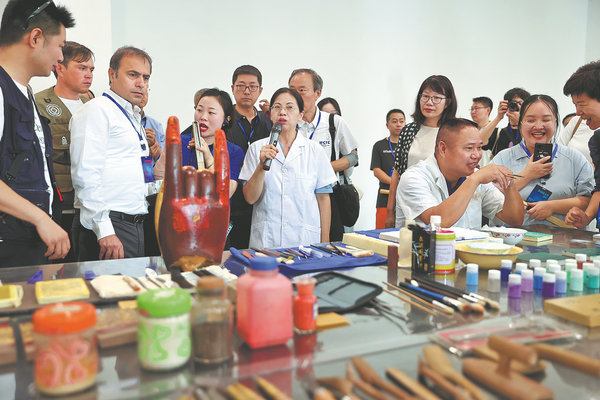 |
| Chen Huili explains her conservation work to international guests at the restoration studio of the Academy of Dazu Rock Carvings, in Chongqing. [Jiang Dong/China Daily] |
Over the years, Chen Huili has developed clever and unique ways to repair damage to priceless artifacts, Yang Feiyue reports in Chongqing.
The light immediately dims and the air feels fresh on the face as you step into the Yuanjue Cave. It takes a little while for your eyes to adjust until you are able to make out the delicately carved Buddha and Bodhisattva rock figurines that have sat there neatly for over a thousand years.
In the low light, Chen Huili points to the lower edges of the outer robes of one of the figurines. "Look at how real and vivid it looks, as if it is real silk fluttering in the wind."
The cave is tucked away in Dafowan, a site that is part of the Baodingshan cluster of Dazu Rock Carvings in Chongqing's Dazu District.
It is 12 meters deep, 9 meters wide and 6 meters high, and is the largest of its kind at the site.
For the past two decades, the accomplished woman, now in her 50s, has been committed to protecting the carvings, which were added to the UNESCO World Heritage List in 1999, the second grotto temple in China inscribed after the Mogao Caves in Dunhuang, Gansu Province.
In addition to the stunning sculptures, other notable features of the cave include its intact drainage system and a natural skylight that allows light to fall directly on the central Buddha figurine, Chen says. "All of this makes Yuanjue extremely valuable."
The trouble is, the flat-roofed cave lacks a central pillar to support its weight.
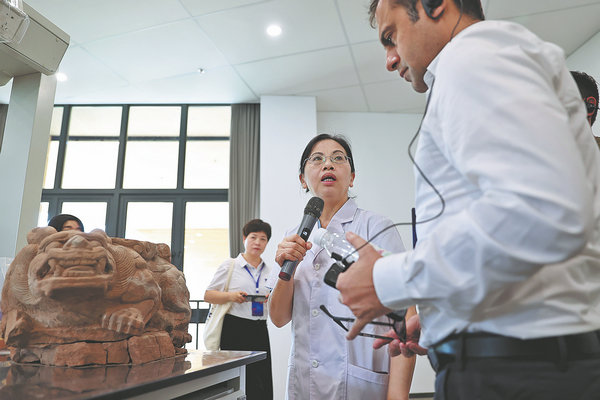 |
| Chen Huili explains her conservation work to international guests at the restoration studio of the Academy of Dazu Rock Carvings, in Chongqing. [Jiang Dong/China Daily] |
"Its ceiling is peeling off in chunks, which poses a significant threat to the stability of the roof," Chen says, adding that some parts are now barely a meter thick.
In 2018, under the approval of the National Cultural Heritage Administration, a preliminary engineering survey of the cave was conducted.
"There's a lot we need to know about it, the most complicated issue being its stability," Chen says.
Other factors range from the extent of the roof's erosion due to water and the condition of the surrounding rock, to ways to reinforce the cave, she explains.
Over the years, Chen has gone from one cave temple to another, taking care of the 50,000-odd statues and images carved into the cliffs that have been placed under her protection, particularly in the Beishan, Baoding, Nanshan, Shimen and Shizuan mountains elsewhere in the district.
Chen came to work at the Dazu Rock Carvings Museum as a cultural heritage monitor and guide in 1995.
As she showed visitors around, she became painfully aware of the threat the passage of time posed to these once beautiful stone carvings.
With a technical school background in material analysis and chemistry, she decided to join the protection center at the Academy of Dazu Rock Carvings.
She wanted to add her own efforts to protecting the sculptures, but it was only after getting involved that she realized it would not be easy.
Restoring the cultural heritage requires a certain level of historical, archaeological, metallurgical and chemical knowledge, as well as practical skills, like stone carving, casting and painting.
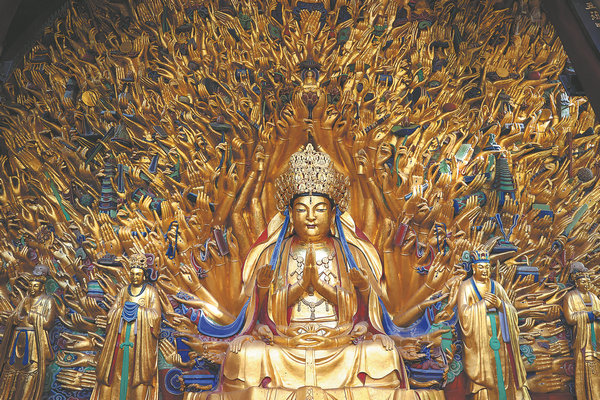 |
| The Thousand-Armed Avalokitesvara in Baodingshan, one of the five major rock carving clusters of Dazu. [Jiang Dong/China Daily] |
Chen caught up on her learning as she worked, asking more experienced colleagues for advice during the day, and studying book on restoration at night.
Her skills grew increasingly more proficient and, after five years of relentless study, Chen became a capable specialist, able to independently undertake restoration work.
As her experience grew, she developed her own distinctive four-pronged approach to cultural heritage diagnosis.
First, she notes all fractures and breaks, as well as the surface condition of the artifacts. She smells their surface to see if she can detect any traces of contamination or mildew, then asks custodians for the history of the changes the artifacts has undergone, before finally gently probing them to see if the surface loosens.
Her analyses have proved consistent with the results of mechanical testing, and so, as a result, Chen has been entrusted with a leading role in protecting the precious stone carvings from the high temperatures and humidity typical to China's southwest.
She has been involved in a number of major projects, one of the most prominent of which involved the eight-year restoration of the Thousand-Armed Avalokitesvara — the goddess of mercy who is known as Guanyin in Mandarin — in Baodingshan, one of the five major rock carvings clusters in Dazu.
The statue originally featured stone carvings, gold plating and elements painted in vibrant colors, but, after more than 800 years, had fallen into a state of disrepair, exhibiting at least 34 different problems, ranging from broken fingers and peeling gold leaf paint.
"Observed at close quarters, it appeared to be pocked with scars," Chen recalls. As the director of the academy's conservation center, she led the subsequent, meticulous restoration project.
Chen and her team did a good deal of research before settling on the methods and materials for the repair.
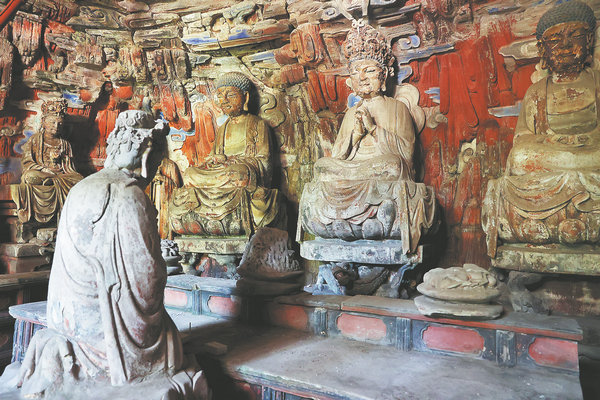 |
| Rock Buddhist figurines in the Yuanjue Cave. [Jiang Dong/China Daily] |
They filled in more than 1,000 survey forms, kept detailed notes of approximately 350 on-site restorations, created 297 hand-drawn images of the various defects, and took over 1,300 photos.
It took Chen's team over three years of effort and some 100 experiments to be able to finally concoct a formula for the optimal adhesive material.
"They have to be suited to the Guanyin statue, which has a sandstone texture, as well as to the high temperatures and humid environment," Chen explains, adding that every decision and move was made based on studies of the statue, its associated history and scientific papers.
For example, she and her team went to Sichuan, Hebei and Shandong provinces to study rock carvings, to try to work out how to mend the statue's broken right hand.
"There was evidence of ancient repair work, but it showed inconsistency with the original," Chen says.
She proposed creating a detachable hand based on the symmetrical features of the statue, because there is still a minor inconsistency in the angle of the remaining bracelet buckles for the hands.
"Therefore, future fixes will be easier to apply, should more issues come to light," Chen says.
During restoration, she and her team stood on the scaffold, facing the cold stone wall and inhaling the pungent odor of the restoration materials every day.
They also had to withstand both oppressive heat and bitter cold as the seasons changed.
"In our line of work, in addition to professional skills, one also requires a superlative degree of patience, a high sense of responsibility and a strong sense of perseverance," Chen says.
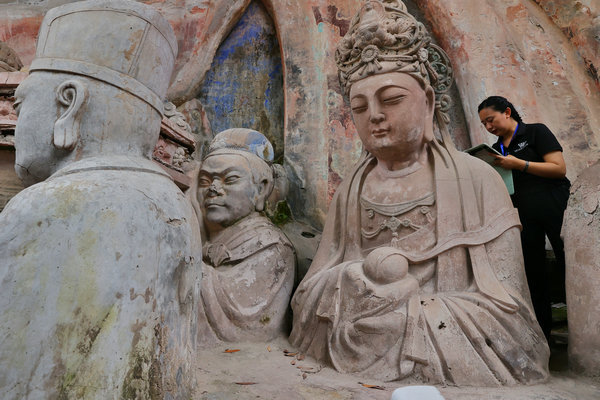 |
| A member of China Academy of Cultural Heritage conducts a survey of figurines at Dazu. [Jiang Dong/China Daily] |
The restoration of the Thousand-Armed Avalokitesvara involved a broad range of disciplines and the participation of numerous experts, and pioneered the restoration of large immovable cultural relics in the country. In 2017, it was honored as a national excellent cultural relic maintenance project.
Today, the statue, restored to its past glory, shimmers and has become a major attraction in the area.
As a result of the feat, Chen has been invited to participate in major restoration projects in Hebei, Gansu and Sichuan provinces.
Her achievements have won her honors, including the National May 1 Labor Medal, one of the highest prizes for working people in China, and a March 8 Red Banner Pacesetter, which is a national honor for outstanding women.
Despite her accomplishments in the field of cultural heritage preservation, Chen remains unsatisfied.
"The simple ailments have already been treated, what remain now are the tough challenges," she says. "This imposes even greater demand for a high level of cultural heritage preservation work."
She believes that it is necessary to enhance the role of technology in cultural heritage preservation, carry out systematic and comprehensive technological protection, and strengthen the development of a skilled workforce.
Chen has played a positive role in training young talent for the protection and restoration of local rock carvings.
Ruan Fanghong, who has been working at the protection center for about six years, says she had heard about Chen before coming to Dazu.
"She helped me restore cultural relics in person, enabling me to experience the importance of being humble in this line of work," Ruan says.
"We must continuously enhance our restoration skills and use technological methods to help prolong the vitality of cultural relics. As members of the next generation, we must shoulder the responsibility of carrying forward traditional Chinese culture," Ruan says.
For Chen, the Yuanjue Cave will remain a focus. To date, preliminary measures such as hydraulic iron frames have been introduced to support the cave roof, while electronic devices have been installed to monitor various parameters of its stability.
Archaeological studies have also been ongoing and three-dimensional scanning has been conducted to preserve the cave's historical information every step of the way.
"In some cases, it takes time, like three to four years, before we can make a judgment and come up with a suitable solution to a problem," Chen explains. "I'm sure there will be many fruitful discoveries further down the line."
(Source: China Daily)
Please understand that womenofchina.cn,a non-profit, information-communication website, cannot reach every writer before using articles and images. For copyright issues, please contact us by emailing: website@womenofchina.cn. The articles published and opinions expressed on this website represent the opinions of writers and are not necessarily shared by womenofchina.cn.








.jpg)

 WeChat
WeChat Weibo
Weibo 京公网安备 11010102004314号
京公网安备 11010102004314号